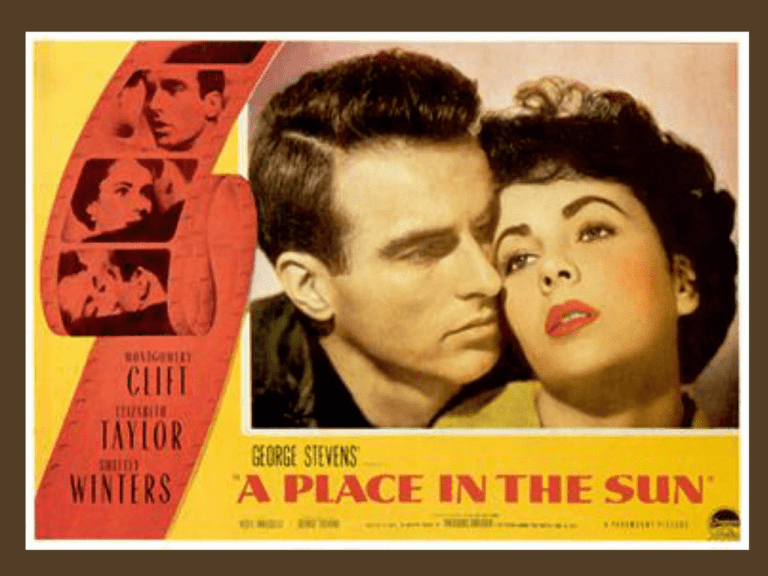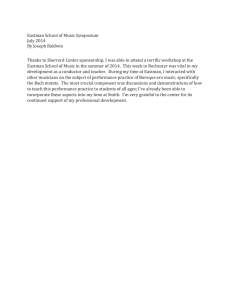A Place in the Sun
advertisement

Origins • The film is actually a remake of Josef von Sternberg's downbeat 1931 film An American Tragedy, starring Sylvia Sidney, Phillips Holmes, and Frances Dee. • Both films are adaptations of Theodore Dreiser's best-selling 1925 novel, An American Tragedy. • Dreiser based his story on the sensational Chester Gillette and Grace Brown 1906 murder case in the state of New York. Cinematic Technique • • • • • • Director George Stevens uses montage, close-ups, and very slow scenes to create an almost dream like atmosphere. The plot moves along slowly but with great fluidity. Similarly the use of steady slow drums as George contemplates murder creates a hot, dark, and menacing atmosphere. The viewer knows that something awful is going to occur. Montgomery Clift’s performance as George Eastman is considered a master class in “method” acting, which was at that time a new paradigmatic challenge to the classical style of acting. In classical acting, everything from speech, emotion, and movement is overly dramatized giving it an unreal quality. The audience could tell that the characters were “acting.” The method, by contrast, was an attempt to try not to “act” through actually becoming the character, making it real, and believable. Along with Clift, Marlon Brando and James Dean embodied this approach. Clift uses his eyes, facial expressions, and deliberately understates his actions, words, and emotions. This is a strong counterpoint to the classical style displayed in all films up to this period—a now outdated style that is gone from acting entirely. Indeed, we laugh if we see anyone attempt to “act” today! Filmmaker Steven Soderbergh attempted to make a classical-style film recently with The Good German (2006) starring George Clooney, Cate Blanchett, and Toby Maguire. The film cost $32 million to make and as of April 2007 had grossed $1.3 million. George Eastman • • • • Who is George Eastman? Hailing from the disreputable side of the family, he is poor, uneducated, and has “run away from home” – abandoning his saintly mother and her missionary work. Is George Eastman is sympathetic character? Do we like him? Do we root for him? Isn’t he nothing more than an outright villain? – – – – • • He craves status, material gain, and excitement. He disobeys company policy by dating, sleeping with, and impregnating a coworker. He constantly lies to Alice and every other honest person he comes into contact with. He contemplates if not commits premeditated, cold-blooded murder. If George is the villain, why do we love him so? Because director George Stevens makes us love him by casting the gorgeous, kind, boyish Montgomery Clift and making him polite and eager to please. • • • • • • • Author Theory: How do you think the director, George Stevens, wanted us to feel about Angela Vickers? How did audiences react to her? Isn’t Angela nothing more than a superficial, spoiled, debutant whose only concern is the who, when, and where of the next social engagement. If this is so, why does George Eastman fall in love with her? Certainly she is beautiful, but she represents the vehicle by which he can achieve all of his desires in terms of economic and social success – something he could never achieve had he stayed at home with his mother. Once again we see a variation on the classic theme: seduction of the father by the daughter and the corresponding destruction of the mother. How so? Angela’s brief phone conversation with George’s mother speaks volumes about this dynamic. Angela sees George at once as both the embodiment of everything that is her father (George is an Eastman after all, is accepted into the family business and will some day run it yet at the same time he appears to be modest, shy, and kind – the exact opposite of her father and the men she normally dates. In this sense she immediately recognizes George as a most familiar/safe person and also the person who can heal the wounds of her inner child. Of course this will never happen as George’s ambition destroys them in the end and she is wounded all over again – this time far worse than before when she was a child. Angela Vickers Elizabeth Taylor was 18 when she played Angela Vickers – her first “adult” role. Alice Tripp: Don’t Rock the Boat • • • • • What was your reaction to Alice Tripp? Did you hate her? Stevens deliberately cast Shelley Winters in this role, rather that say Elizabeth Taylor. Why? Isn’t Alice the most honest, genuine, good person in the film. Isn’t she someone to be respected and admired? She is single, has a job, lives alone is a nice place, and has innocently fallen in love with someone just like her: a shy, basically good kid from a modest background. How did young female audiences react to Alice? Did they want to grow up to be just like her? Did they want to be just like Angela Vickers? What about young men, are they looking to marry the Alice Tripps of the world or the Angela Vickers’? Abortion in a pre-Roe World • • • • • • Is the word “abortion” ever used? No, as it was forbidden by the censors. How was the topic of abortion handled? What was the doctor’s reaction? How is single-motherhood portrayed? Would the topic be handled differently if this film had been made post-Roe v. Wade (1972)? The Prosecutor • • What do we learn about prosecuting attorneys from Raymond Burr’s portrayal of District Attorney Marlowe? How is his demeanor throughout? – He is overly dramatic and blatantly violates courtroom procedure in order to “play to the jury.” • What techniques does he use at the trial to win the case? – Circumstantial evidence: the couple quarreled before they got to the lake, George rented the canoe under a false name, the coroner concluded Alice had been struck by a blunt instrument before she drowned. – Using the canoe and oar to physically illustrate the crime. – What about the rope? Was this the prosecutor’s great mistake? • • Why does he prosecute this case when he only has circumstantial evidence (why not plea bargain, which is what happens in 9 out of 10 cases anyway)? Because the DA is going to ride the coattails of this case into the Governor’s Mansion and then on to the White House. Raymond Burr was so good at his role and audiences loved him so much in this genre that he went on to play another criminal attorney in “Perry Mason” every week on CBS from 1957-66. He then played a wheelchair bound detective each week in “Ironside” from 1967-1975. He returned to his role as “Perry Mason” in over two dozen TV movies from 1985 until his death in 1993. Morality • The smallest indiscretions can grow into big problems. • A weak-minded individual can succumb at a crucial moment and have the rest of society turn its back on him. • Desire v. Deed: If you have decided to do something evil, then change your mind before you do it, are you as guilty as if you had? If not, why? If so, where is the line drawn between deciding upon an evil action and entertaining the idea? Class: Keeping up with the Eastman’s and Vickers’ • • • • • How are class differences portrayed in the film? The film is set in idyllic 1950s upstate New York. Is it a coincidence that Rochester, NY is where Eastman-Kodak is headquartered? George Eastman embodies the American myth of rugged individualism as he works his way from his Midwestern, lower-class, religious fundamentalism up the elite, east-coast, corporate ladder despite his lack of education and training. Of course he knows someone to get in the door, which is another powerful yet somewhat contradictory American myth. Angela is protected from the trial and press because of the bargain struck by the rich and powerful: the DA and George’s Uncle. She is not required to testify and her name is never mentioned in any way: only “another woman” is referred to. Is the theme of class difference (economic/social status) outdated as this film was made over 40 years ago? Conclusion • • • • • • • • • Did George kill Alice? It’s just a bunch of circumstantial evidence. The director, George Stevens, deliberately chooses NOT to show us the alleged murder (just as Hitchcock never showed us the murder in Rebecca). Why? By selectively disclosing bits of circumstantial evidence, the filmmaker can lure the audience into the wrong conclusion about what actually happened; and then the filmmaker springs the trap! In terms of author theory, the circumstantialevidence filmmaking technique is meant to be an argument about the imperfections of formal legal structures. If “innocent” persons are convicted on the basis of circumstantial evidence, is justice served? Well, we don’t really care do we as long as it’s the disadvantaged – in this case a poor, uneducated, boy – who are caught up in that system. So although we may never know whether George killed Alice, it doesn’t bother us very much because he is expendable. Do you think audiences got this point? Do you think that they believed George was innocent and should be set free so that he can live happily ever after with Angela Vickers? Would they live happily ever after?


